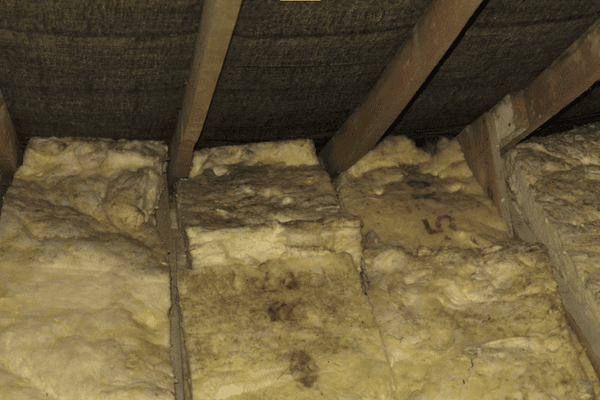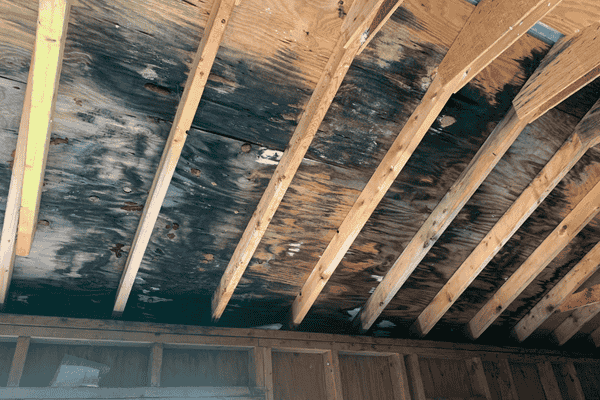Have you ever ventured into your attic and caught a whiff of that distinct, musty odor lingering in the air? Or perhaps you’ve noticed some suspicious dark spots peeking out from your attic plywood? If so, congratulations! You’ve just uncovered an unwelcome guest – attic mold. While these creatures thrive in darkness and humidity, you, my friend, have the power to evict them.
At Howard Environmental, we understand that the issue of attic mold can be daunting for homeowners. Mold isn’t just an unsightly mess; it poses serious health risks and can wreak havoc on your home’s structure. Your attic may be out of sight, but it certainly shouldn’t be out of mind. Our goal today is to illuminate the causes of attic mold and arm you with effective solutions to ensure a mold-free haven above.
What Causes Attic Mold Growth?

When it comes to mold in the attic, understanding root causes is half the battle. Turns out, there are a few repeat offenders of mold activity, and we’re here to shine a light on them.
Moisture- The Primary Culprit
The first suspect on our list? Moisture. It should come as no surprise that mold needs moisture to grow. Humidity levels above 60%, coupled with condensation accumulating from temperature fluctuations, can form the perfect breeding ground for these pesky spores.
For instance, if your attic isn’t properly insulated and warm air from your living space seeps in, condensation forms. The result? Mold. So, if you suspect your humidity levels are on the rise in Texas, consider monitoring them closely!
Poor Ventilation: A Recipe for Disaster
Next up is the issue of ventilation. You might think, “Hey, it’s just an attic. How much air does it need?” Well, if you’ve ever tried cleaning a closed gym bag after a workout, you know exactly what stale air feels like!
Poor ventilation means that cooler air can’t circulate, creating discord between hot and cold temperatures. The lack of airflow can lead to humidity buildup, which is as close to a five-star resort for mold as you can get.
Insulation Issues
Insulation may be doing its job keeping you cozy, but if it’s improperly installed or even worse, wet, it can become an escalation point for mold growth. Think of it as a wet sponge – what happens when you don’t wring it out? It grows mildew!
If you’re faced with wet attic insulation, it’s crucial to act quickly. Mold loves hiding in the nooks and crannies of insulation, where it can wreak havoc on your home and health.
Roof Leaks: Structural Woes Leading to Mold
Roof issues are the final major culprit of attic mold growth. A minor leak may seem inconsequential, but it can introduce moisture over time, turning your attic into a mold-friendly environment. Watch out for water stains on your ceiling or walls; these may signal that your roof needs some TLC before mold takes hold.
The Mold Manifestation: Signs It’s Time to Act
Now that we’ve identified the culprits, let’s move on to spotting the signs of mold. Trust us when we say that catching it early can save you a lot of frustration down the road.
Visual Clues: Spotting Mold Growth Early
Look for any discoloration on your attic plywood or rafters. If you notice black or green spots, mold may already be negotiating a long-term lease in your attic.
Odor Alerts: Smelling Trouble in the Air
A musty smell wafting through the air? Unfortunately, that’s not the smell of grandma’s cookies baking! It’s an alarm bell signaling that mold could be making its presence known. Pay attention to any peculiar odors in your home, especially in the upper levels.
Health Symptoms: When Mold Affects Your Family
Lastly, be aware of any health effects experienced by you or your family members. Mold exposure can cause a range of issues from hay fever-like symptoms to more severe respiratory concerns. If you’re feeling off and suspect mold, don’t ignore it!
Fixing It Fast: Your Guide to a Mold-Free Attic
Okay, so now you’ve pinpointed mold in your attic — the real question is, what do you do about it? Don’t worry; we’ve got you covered.
DIY Solutions: Tackling Minor Mold with Confidence
If you’re only facing minor mold growth, you might consider doing a little DIY action. For small patches, mix equal parts water and white vinegar (don’t worry, your attic won’t smell like a salad). Grab a scrub brush and some rubber gloves and gently scrub away! Make sure to wear proper protective gear to avoid any health risks while cleaning. If it’s on insulation, simply replace it altogether!
When to Call in Professionals: Knowing Your Limits
Still seeing spots no matter how much elbow grease you use? It’s time to call in the pros, like us here at Howard Environmental. We recommend reaching out when mold covers a significant area (more than 10 square feet), or if you suspect there’s underlying moisture causing the issue. An expert assessment can save you time, money, and many sleepless nights.
Prevention Tips: Keeping Mold at Bay for Good
Finally, let’s ensure mold doesn’t come knocking again. Good practices can keep your attic in pristine condition:
– Check and maintain your roof regularly. Look for leaks or missing shingles, and consider a professional inspection if necessary.
– Optimize insulation and ventilation. Ensure proper insulation installation and good airflow to prevent that humid air gathering upstairs. Solar-powered ventilators can be a game changer!
– Monitor humidity levels. Invest in a hygrometer and keep humidity levels below 60%. If it gets too humid, consider using a dehumidifier.
Next Steps: Don’t Let Mold Win
If there’s one thing we hope you take away today, it’s this: Understanding the causes and signs of attic mold can provide you with the tools to confront it. But, if things become overwhelming, don’t hesitate to reach out for help!
Schedule a Professional Inspection: Get the Expert Opinion
At Howard Environmental, we invite you to schedule an attic mold inspection for peace of mind. We provide comprehensive assessments that aren’t influenced by remediation incentives. We’re here to help you navigate these concerns, giving you the best options tailored to your specific needs.
Transparent Support: We’re Here to Help
With our transparent pricing and commitment to your wellness, we want to ensure you feel supported and informed every step of the way. We’ll share the facts and empower you with DIY tips, should you choose to tackle any issues yourself.
Conclusion: Breathe Easy in a Mold-Free Home
As we close this chapter on attic mold, remember that timely intervention is essential to protecting your home and family’s health. The sooner we address this hidden threat, the better equipped you’ll be to breathe easy and enjoy a mold-free space.
Don’t wait for mold to become a bigger issue; contact Howard Environmental today. Let us guide you in turning that attic threat into a safe, clean sanctuary for your home. Together, we can minimize risks and maximize comfort!

